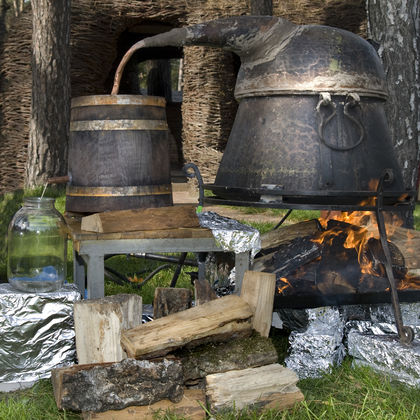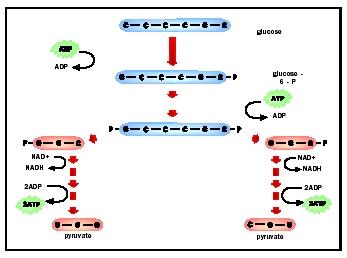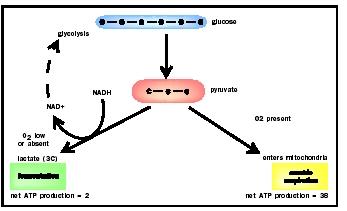Glycolysis and Fermentation

Glycolysis is an anaerobic metabolic pathway, found in the cytosol of all cells, which forms adenosine triphosphate ( ATP ) by degrading glucose . It also serves as a source of precursors for other pathways, and as a recipient of products of various pathways for use as metabolic fuels. Its universal and central role in metabolism suggests that glycolysis evolved early in the history of life.
In the overall reaction for glycolysis, one molecule of glucose is converted to two molecules of pyruvic acid. Along the way, two molecules of adenosine diphosphate ( ADP ) are phosphorylated to ATP, and two molecules of NAD (the oxidized form of NAD, or nicotinamide adenine dinucleotide) are reduced to NADH. ATP serves as an energy carrier and can be used to power many cellular processes. The NADH carries high-energy electrons, which can be used to produce more ATP by chemiosmosis . Likewise,

The ten steps of glycolysis can be divided into two stages. The first five steps, the preparatory, or priming, phase of glycolysis, prepare the glucose by phosphorylating it twice, using two molecules of ATP as sources of phosphate. This increases the energy content of the glucose, so the preparatory phase is also sometimes called the investment stage, reflecting the need to invest two ATP molecules before a net yield of energy can be achieved. During the second five reactions, the payoff phase, the fructose-1,6-bisphosphate formed during the preparatory phase is dephosphorylated and cleaved, forming two molecules of pyruvate and four of ATP. Because two ATPs are used and four are produced during glycolysis, there is a net production of two molecules of ATP for every glucose consumed.
Since glycolysis plays a central role in cellular metabolism, it has several control points. Like most pathways, it is regulated during its early steps. Hexokinase, the enzyme that catalyzes the first reaction, is inhibited by its product, glucose-6-phosphate (G-6-P). The third enzyme, phosphofructokinase (PFK), is regulated in a complex manner by several metabolites , and is also under indirect hormonal control. The last glycolytic enzyme, pyruvate kinase , is regulated by several metabolites, including ATP, which inhibits it. These control mechanisms have the effect of maintaining a constant supply of ATP for the cell, since production of ATP inhibits the process, and depletion of ATP activates it.
Aerobically respiring cells will produce even more ATP through oxidative phosphorylation . However, cells that cannot respire aerobically , either because they lack the necessary metabolic pathways or because they live in anaerobic environments, cannot do this. This presents a problem since all cells must continually regenerate the NAD needed during the

SEE ALSO Carbohydrates ; Krebs Cycle ; Oxidative Phosphorylation
David W. Tapley
Bibliography
Bodner, G. M. "Metabolism: Part I, Glycolysis." Journal of Chemical Education 63 (1986): 566–570.
Sparks, S. "The Purpose of Glycolysis." Science 277 (1997): 459–460.
Comment about this article, ask questions, or add new information about this topic: